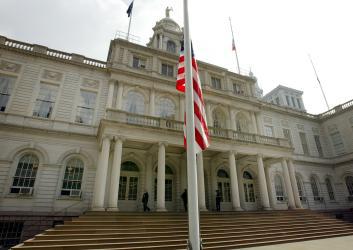When debating policy, anecdotes are like landfills: There are a lot of them, they take up a lot of space, and they’re all garbage. I think that’s why I can’t lend my voice to the chorus of praise for this recent Atlantic article about alleged inequities in the New York City criminal justice system. In the piece, a white former prosecutor named Bobby Constantino puts on a suit, heads to Brooklyn, and deliberately tries to get arrested for possession of graffiti instruments. But no one will arrest him, and Constantino concludes that the justice system works very differently for white people than it does for black people. Constantino’s conclusion is undoubtedly true. But I’m not sure that his story does very much to prove it.
Under the headline “I Got Myself Arrested So I Could Look Inside the Justice System,” Constantino writes that he worked as an assistant district attorney in Boston until he grew disheartened about constantly having to prosecute young black men for petty crimes for which white men never would have been arrested: “riding dirt bikes in the street, cutting through a neighbor’s yard, hosting loud parties, fighting, or smoking weed.” Determined to test the limits of white privilege and hopefully “see the system in action,” Constantino acquired some spray paint and a large graffiti stencil and walked around various Brooklyn neighborhoods (never spraying the paint) trying—and failing—to get arrested. Double standards in action, right?
Well, maybe. But the problem is that this was an uncontrolled experiment, and we have nothing to directly compare Constantino’s results against. Did the cops refrain from arresting him because he was white? Was it because he was wearing a suit? Or was it just that, contrary to Constantino’s claim that “carrying those items qualified as a class B misdemeanor pursuant to New York Penal Law 145.65,” the law actually says that possessing graffiti instruments is only a crime if they are possessed “under circumstances evincing an intent to use same in order to damage such property.” Maybe, in the cops’ eyes, Constantino wasn’t “evincing an intent” to tag any buildings. Maybe they could sense that he was pulling some sort of stunt, and that they didn’t want to be involved in it. Maybe, as Constantino concludes, they don’t think white guys are going to spray the paint. We just don’t know.
After failing to get arrested in Brooklyn, Constantino raises the stakes and actually spray-paints “NYPD Get Your Hands Off Me” on the walls of New York’s City Hall—during which, in an admittedly unbelievable moment, he is spotted by a cop who then proceeds to drive away without making an arrest. Constantino then returns to City Hall the next day to surrender himself. Instead of being arrested, he is turned away; and the same thing happens each of the next four days. “I was expecting them to recognize me from eyewitness descriptions and the still shots taken from the surveillance cameras and immediately take me into custody,” he writes. “Instead, the guard politely handed me back my license, explained that I didn’t have an appointment, and turned me away.”
Constantino interprets his inability to get arrested at City Hall as the cops’ reluctance to arrest a white man. But isn’t it just as likely that the City Hall guards were just confused by the whole situation? Misdemeanor criminal suspects don’t normally surrender themselves at City Hall. They do so at the police station, and, wouldn’t you know, there is actually a police station only steps away from City Hall. If Constantino would have surrendered himself there, only to be turned away again and again, well, that would be a story. But surrendering yourself at City Hall is sort of like demanding that the Department of Agriculture process your tax returns. Just because they won’t do it doesn’t mean that the government doesn’t want your money. (As for the cop who drove away: Do I think that a black man spray painting a message to the NYPD on the side of City Hall would have gotten that cop’s attention? Yes. Do I know that the cop drove away because Constantino is white? No.)
I’ve been writing about stop-and-frisk all year, and the reason why the stop-and-frisk lawsuits were so maddening is because they revealed an obvious, impossible-to-ignore pattern of racist behavior on the part of the NYPD; a decade’s worth of civil rights violations targeting specific ethnic groups. Constantino’s story says nothing relevant about anyone or anything other than Bobby Constantino and the circumstances of his stunt crime. Would a black man have had an easier time getting arrested for the same actions? Probably. But we know that because of the myriad statistics showing that blacks are arrested at a higher rate than whites in New York, not because of Constantino’s anecdotal evidence and presumptions.
Constantino eventually does get himself arrested, and, in the Atlantic piece, he spends a great deal of time describing the dire conditions in the police holding cell where he is taken. You should read the whole article if you haven’t already. Maybe you’ll find his anecdotes compelling. I don’t know. The story is interesting, and it’s clear that Constantino means well, but, in the end, I just don’t think it says anything significant.
